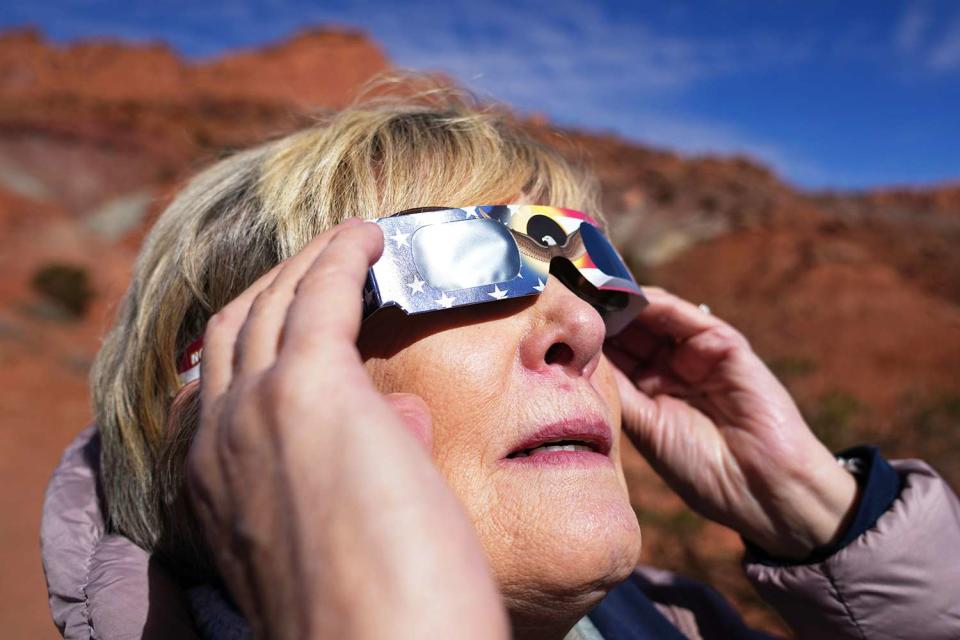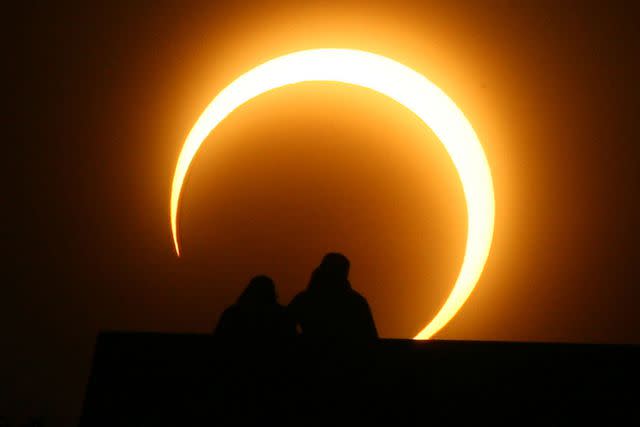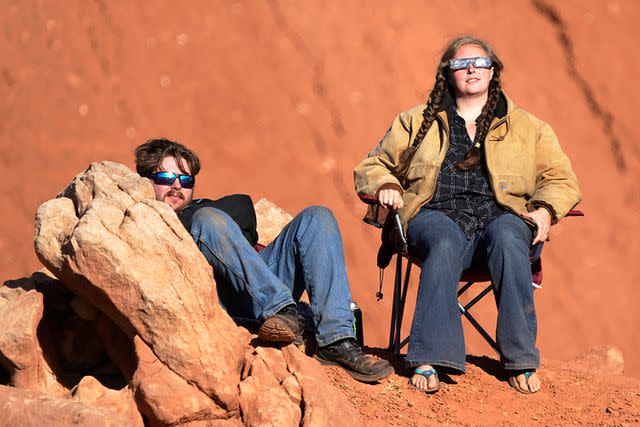Where to Buy Solar Eclipse Glasses? All About the Specialized Glasses Recommended by NASA
The April 2024 total solar eclipse will be the last one visible from the contiguous United States until 2044. Here's how to prepare for it

George Frey/Getty
Solar eclipse glasses.It's time to add another pair of sunglasses to your collection!
However, this particular pair isn't for fashion purposes — rather, it's for protection when viewing the upcoming total solar eclipse that's expected to take place in April 2024.
Think back to the last time a total solar eclipse was visible from the United States in April 2017, when NASA advised onlookers to watch the astronomical phenomenon with specialized eye protection. This year is no different!
The space agency recommends protective eye gear for those hoping to catch a glimpse of this highly-anticipated event, particularly for the phases before and after totality (which is when the moon completely blocks the sun's bright face).
Related: Here's What Leap Day Could Mean for You, According to Your Zodiac Sign
Even without an astronomical event that causes people to gaze directly at the sun, doctors advise people wear a good pair of shades in bright weather; that's because, as NASA warns, viewing "any part" of the sun "without a special-purpose solar filter secured over the front of the optics" will "instantly cause severe eye injury."
It's important to note, however, that the protective eyewear the agency suggests using to watch the solar eclipse is not the same as regular sunglasses. Plus, they shouldn't be used when viewing through cameras, binoculars or telescopes.
Read on for what you need to know about the NASA-recommended glasses to watch the 2024 solar eclipse, including when and where to buy them.
What is a solar eclipse?

STR/AFP via Getty
Solar eclipse viewed from China in January 2010.A solar eclipse happens when the moon passes between the sun and the Earth, according to NASA. The moon enters different phases during an eclipse.
At just the right moment, a total solar eclipse occurs when the moon passes over the sun and blocks out its bright light completely. Other times a partial solar eclipse takes place, when the moon only covers part of the sun's glow.
A total solar eclipse is quite a spectacle to experience if the astronomical phenomenon is visible from your location on Earth. The April 2024 solar eclipse, which will be visible in the U.S., is expected to take place midday, causing daytime darkness for a few minutes as a result.
"If you want to experience total darkness during an eclipse, you have to be in the path of totality," reports NASA. "If you don’t know what’s happening, it can be confusing. Animals can get confused too!"
Related: All About October's Solar Eclipse and What It Means For Your Zodiac
When is the solar eclipse in 2024?
The upcoming solar eclipse is Monday, April 8, 2024. Exact timing depends on where viewers are located in North America, where the phenomenon will pass after it begins over the South Pacific ocean.
"Weather permitting, the first location in continental North America that will experience totality is Mexico’s Pacific coast at around 11:07 a.m. PDT," per NASA. Next, it will enter the U.S. in Texas.
Then, it travels through Oklahoma, Arkansas, Missouri, Illinois, Kentucky, Indiana, Ohio, Pennsylvania, New York, Vermont, New Hampshire and Maine, as well as small parts of Michigan and Tennessee. (Those interested in experiencing the complete solar eclipse should look up exactly where in their state is within the path of totality; many well-situated towns are hosting events to celebrate!)
After it makes its way over the U.S., the eclipse will enter Canada. It will exit continental North America on the Atlantic coast of Newfoundland, Canada, at 5:16 p.m. NDT.
What are solar eclipse glasses?

George Frey/Getty
A couple with solar eclipse glasses view the solar eclipse from Utah in October 2023.Solar eclipse glasses are specialized eyewear recommended by NASA to watch the solar eclipse, and are specifically made out of materials that enable safe sun viewing.
"Solar eclipse glasses use lenses that are made of black polymer, a flexible resin infused with carbon particles," according to the Planetary Society's website. "They are about 100,000 times darker than ordinary sunglasses and block nearly all visible light as well as all infrared and ultraviolet light."
Eclipse glasses aren't the only form of protective eyewear onlookers are suggested to use. Handheld solar viewers are another option if you can't snag a pair of glasses.
NASA states that it "does not approve any particular brand of solar viewers." (The American Astronomy Society does have a list of reputable vendors on their own site.) However, NASA emphasizes that people hoping to look right at the sun must be wearing a pair, as regular shades "are not safe for viewing the sun" during the eclipse.
Do solar eclipse glasses have to be worn?
Solar eclipse glasses and handheld solar viewers are strongly recommended by NASA to watch the phenomenon in its partial phases as a way to prevent eye damage from the sun. There are other ways to watch, though, if you don't want to purchase and wear this gear.
NASA offers an indirect viewing method, which does not involve looking directly at the sun. Using a pinhole projector, for example, is one way onlookers can experience the eclipse.
A pinhole projector has a tiny opening (like a hole punched in an index card) and projects an image of the sun onto a nearby surface. While facing away from the sun, the space agency says that viewers "can then safely view the projected image." (Do not look at the sun through the pinhole!)
There is also a brief window of totality (when the moon completely covers the sun) when NASA notes the eclipse is viewable "without proper eye protection." The only safe time is when you can "no longer see any part of the sun through eclipse glasses or a solar viewer."
Related: Fly in the Path of Totality During April's Total Solar Eclipse on This Delta Flight
Where and when to buy solar eclipse glasses?

APHOTOGRAFIA/Getty
A couple watches the solar eclipse with protective eyewear from El Salvador in October 2023.So what exactly are you looking for to ensure you are buying the correct type of glasses?
"Safe solar viewers are thousands of times darker and ought to comply with the ISO 12312-2 international standard," according to NASA.
The space agency links to a resource page with vetted companies that manufacture and sell safe solar viewers and filters for binoculars and telescopes; according to NASA, these sellers have "demonstrated" that the products they're selling "meet the safety requirements" of the above standard.
The resource page does not recommend searching for eclipse glasses on Amazon, eBay, Temu or any other online marketplace and buying from whichever vendor offers the lowest price. Before making an online purchase, make sure the seller is "identified on the [NASA] site."
As for when you should buy your solar eclipse glasses, Forbes suggests purchasing them now. This is because demand for the product will only increase as April 8 draws closer, which will likely increase prices as a result.
"According to the e-commerce accelerator Pattern, the prices of solar eclipse glasses have increased by 27% online since the last solar eclipse in North America on October 16," the outlet reported on March 7 — and based on supply-and-demand, prices will likely only increase from here.
For more People news, make sure to sign up for our newsletter!
Read the original article on People.

